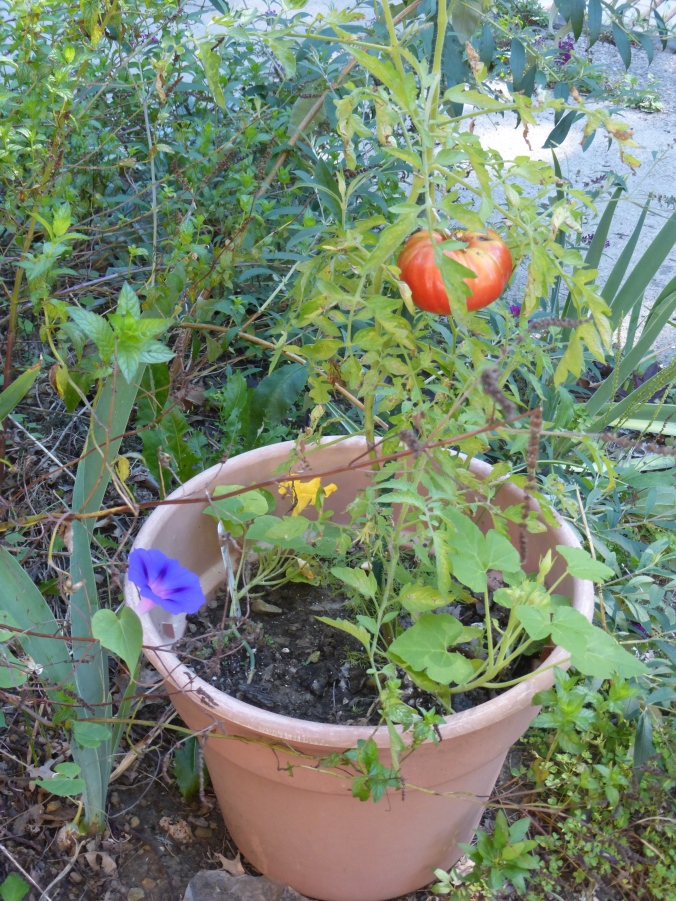
Tomato plant and squash plant in a pot, in the garden among morning glories, irises, spearmint, etc.
I’m writing a 3-part series on composting over at Kitchen Stewardship; here’s how to get started with my composting system using 3 ordinary flowerpots, and I also mention two FREE composting systems my family members have used. Here, I’m explaining my general approach to the garden I nourish with my compost.
The idea and the name of Darwinian Gardening come from my mom, who devotes a section of her large garden to “the survival of the fittest,” with lovely and sometimes surprising results.
You could just fertilize some soil and then see what grows there, being totally hands-off about it. Mom and I intervene a little. The basic idea is to plant the seeds you have and encourage the plants you like, to grow a uniquely beautiful garden that’s environmentally friendly, inexpensive, and low-maintenance.
I don’t have a big garden like my parents do. My front yard is about 12 feet square. My back yard (not shown in these photos) is on a cliff and very shady, so we struggle to keep anything growing there to control erosion. One of my favorite things about Darwinian Gardening is that many species of plants intertwine, creating lots of variety in a small area. My garden may be tiny, but there’s a lot to see here!
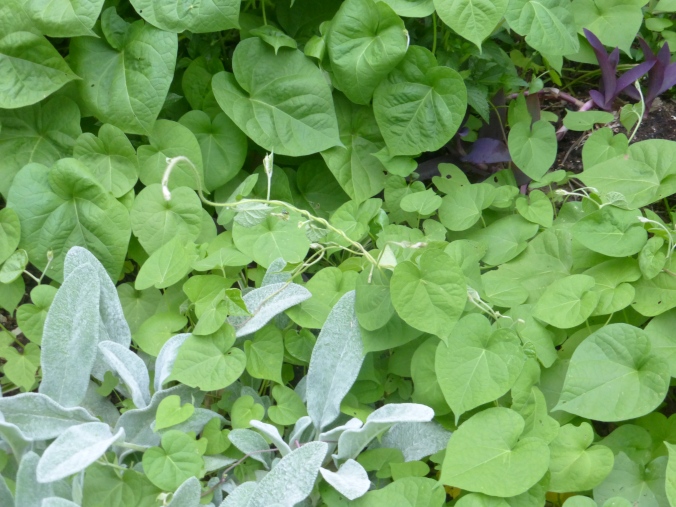
Morning glories, lamb’s ears, and purple vine working together to choke out “weeds.”
My garden combines things I planted on purpose with things that just showed up. Every spring, I plant whatever seeds I have, root cuttings from my potted plants, and maybe buy a few bulbs or seeds or seedlings.
A lot of my plants “grow like weeds” and are essentially invasive species, but I don’t consider them “weeds” because I like them! I only pull up plants I truly don’t want, like poison ivy and burrs.
However, my most enthusiastic plants sometimes choke out other plants that I want to grow, so I intervene by digging them up and moving them to a bare spot. Morning glory vines twine around other plants and block the sunlight; while I’m supervising my kids playing outdoors, I patrol the garden and carefully unwind morning glories from the other plants and wind them onto things I don’t mind them growing on.
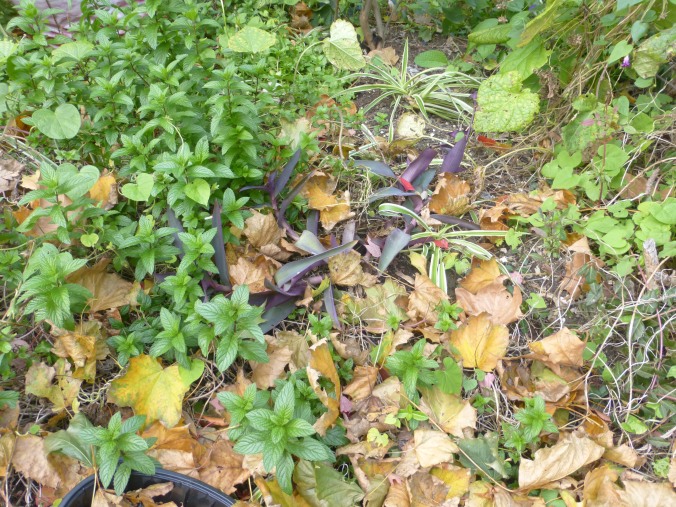
Spearmint, purple vine, and spider plants among the first fallen leaves of autumn.
The spearmint really took over last year! We started it about 5 years ago, with 3 stems that Daniel’s mother brought us; we put them in a vase of water until they grew roots and then planted them in the yard. We’ve had a little more mint each year, as it spreads underground. Then we had two years in a row when I failed to get out and pull up all the dead stems after frost, and many other plants did not grow well with a thick layer of woody mint stems on the ground, but the mint itself thrived!
Last summer, most of the yard was waist-high spearmint, and it even choked out the morning glories to some extent. That was too much mint! In an effort to rein it in, I pulled out all the stems, dug up some of the roots (and planted them in the back yard), and put sheet mulch over the areas that had been exclusively mint. We’ll see . . . so far, a few sprigs of mint have come up, but I think it might be less than at this time last spring. I’m pleased that my tulips came up right through the sheet mulch.
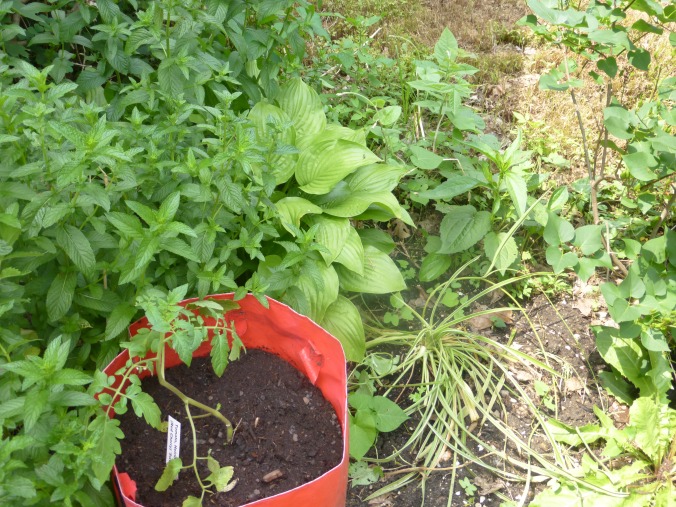
Early summer: a tomato seedling newly planted in a pot, among spearmint, hosta, and spider plant, with black-eyed susans coming up in the background and the lilac bush at right.
My garden is mostly about flowers, but I like to grow a few edible plants. I put the tomatoes in pots or flexible planters to make sure they’ll have enough loose, clean soil to spread out their roots. (The soil native to our yard is a heavy clay.)
Squash vines often grow from seeds we discarded in our compost. One of these grew a very delicious squash! Usually, though, they start growing kind of late in the season and only produce pretty yellow flowers.
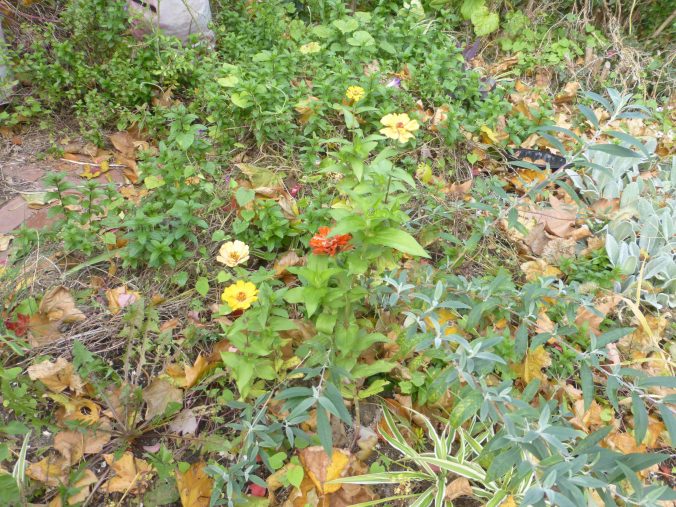
Zinnias growing right in the middle of the butterfly bush, with a spider plant and a few morning glory vines and a dandelion.
There are 4 bushes in our little front yard: lilac and butterfly bushes I bought, a hydrangea bush I rescued from a co-worker who’d received it as a potted plant and tired of it when it stopped blooming, and a privet bush we don’t really want but are afraid to dig up because it’s over the gas line. I encourage the bushes I want, making sure they get enough light and water. The privet bush gets cut back as much as possible every spring and fall, and during the summer I let morning glories grow all over it!

Purple vine newly transplanted from a pot, competing with squash and morning glory vines.
My potted plants, which are in the house over the winter and on the porch railing in the summer, are spider plants and a purple vine called Wandering Jew or Purple Heart. Both species spread well and like all types of soil. When I transplant them to new pots, I sometimes break up the root clump and plant part of it in the yard. I also take cuttings (for the purple vine, just break off a piece; for a spider plant, wait for it to make “spiders” or baby plants that hang off the mother on long stems, and cut those off; put the broken end of the vine or the base of the spider in water until roots grow) and plant those in the yard. They don’t survive the winter, but they grow well during the summer!
Our neighbor on one side was disabled and in poor health, so she wasn’t able to maintain her yard. One year, aside from the privet hedge around the perimeter, her entire yard filled with burr plants six feet tall!! The burrs actually blew onto our clothes as we walked by, in addition to blowing into our yard and attempting to grow more burr plants the next year. We decided we couldn’t let that happen again, so the next year we repeatedly pulled up burr plants from her yard. That allowed our morning glories to spread, covering most of the ground in her yard as well as climbing the hedge. We were thrilled with the abundance of purple flowers! That neighbor died last winter, and the people who bought her house cut down the hedge; we hope they’re going to do something pleasant with the yard.
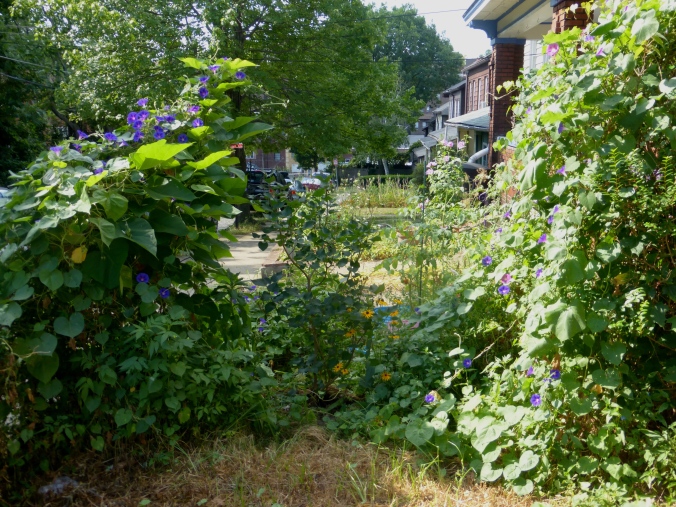
Looking across the neighbor’s yard into mine at peak morning glory season. The vines were using an upstart catalpa tree as trellis on the left and completely covered the privet bush on the right. My lilac bush in the center was carefully kept free of vines.
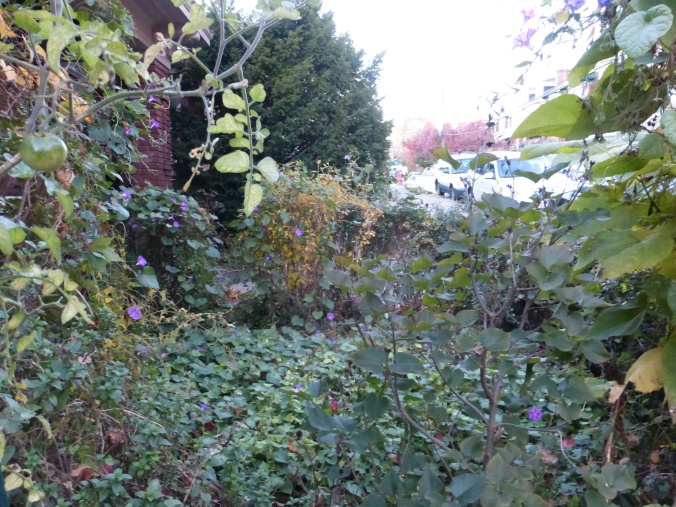
Looking through my garden into my neighbor’s in the autumn, the year morning glories covered the ground.
Darwinian Gardening is never going to fool anyone into thinking I hired a landscaper–but that’s not my goal. What I want is a little patch of nature where my family and I can enjoy spending time among plants that are pretty and thriving but not too tame. I love the way it’s different every year!
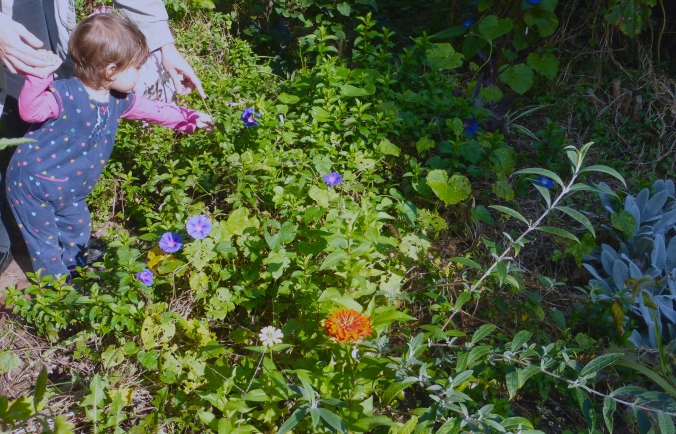
Lydia and Daddy notice a morning glory amid the spearmint and zinnias, near the butterfly bush and lamb’s ears.
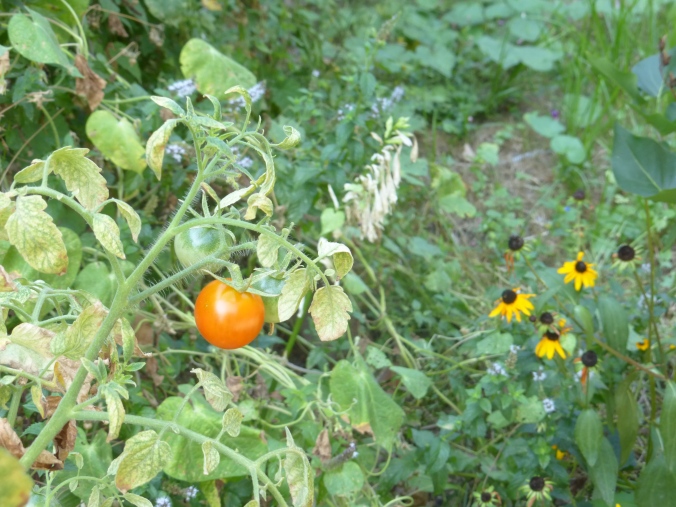
Cherry tomatoes above the little purplish-white daisy-type things, fading hosta blossoms, and black-eyed susans.
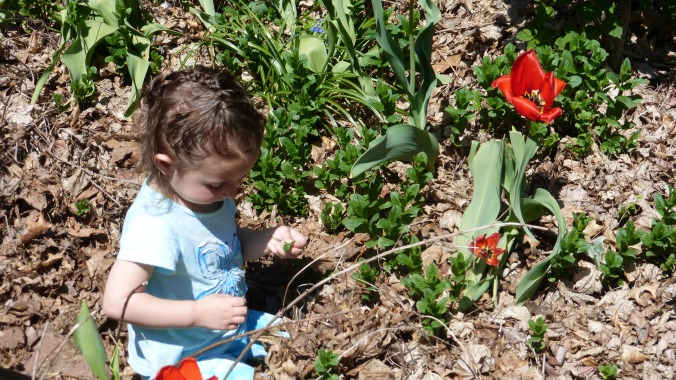
In the spring, tulips and spearmint come up through the thick layer of dead leaves that I spread on the garden in the fall. At the top center of this photo is a little blue flower–I forget what those are called; they were free bulbs that came with my order a few years ago.
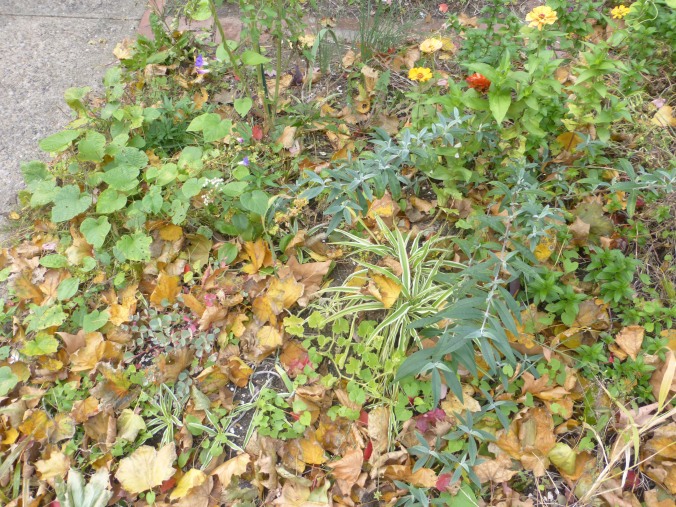
Autumnal array!

Look closely at the top, near the left–that’s a tomato plant that came up from compost; it produced several sweet, green-striped yellow tomatoes! I let morning glories grow all around the edges of this area but pulled them off the tomato plant, butterfly bush, spider plant, iris, and sedum (the bluish plant just below center).
Visit the Hearth & Soul Link Party and To Grandma’s House We Go! and Be Clean Be Green with Kids for more springtime inspirations!
I found this post so interesting, Becca! I had not heard of Darwinian gardening before but it makes a lot of sense. Your garden looks so beautiful and abundant. Thank you so much for sharing with us at Hearth and Soul.
Pingback: Compost Blanketing the Sahara | The Earthling's Handbook
Pingback: A Look At Climate Change And The Questions That Surround It | The Earthling's Handbook
Pingback: Eco-Friendly Kitchen Renovations | The Earthling's Handbook
Pingback: Gardening is Good for You! {infographic} | The Earthling's Handbook
Pingback: Top 17 Articles of 2017 | The Earthling's Handbook
Pingback: A Morning Glory Moment on Earth | The Earthling's Handbook
Pingback: Mulch with Autumn Leaves, Bring a Beautiful Spring! | The Earthling's Handbook